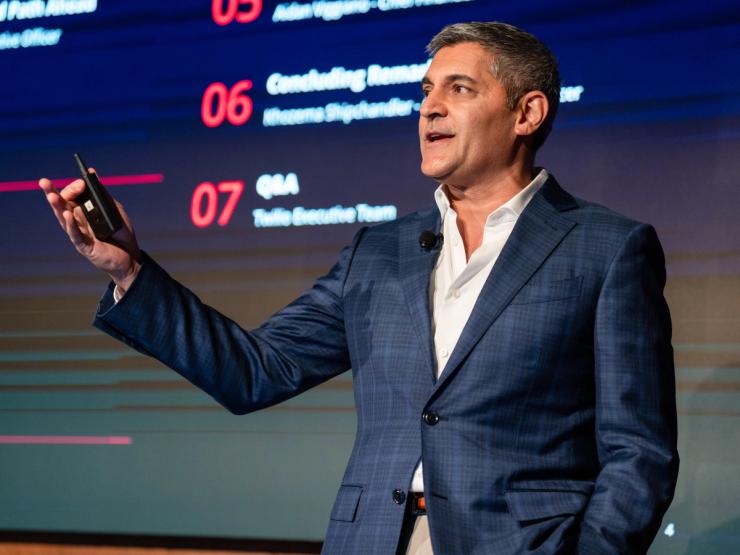The Signal Interview
Khozema Shipchandler has a vision: that every digital interaction between a business and its consumers will be “amazing.” Twilio, the $15 billion-plus company he has led since January 2024, sells customer engagement software to most of the S&P 500, handling text messages and emails for brands such as Nike and Domino’s Pizza.
Yet Twilio’s surveys suggest just 45% of consumers feel understood by the brands they interact with, and “most of our interactions with brands are actually quite poor,” he notes. Companies have plenty of data on their consumers’ demographics and purchase history, he says, but need to do better at personalizing their communications by adding context to that data — knowing which customers can be nudged to spend more with a special offer, and when. Weaving this “contextual data” into brands’ communications, he argues, is the key to unlocking returns on their AI investments.
Shipchandler, who began his career at Jack Welch’s GE, was elevated from the CFO position after pressure from activist investors on his predecessor, co-founder Jeff Lawson. Twilio had enjoyed strong topline growth, but Shipchandler’s challenge was to make it solidly profitable.
The company’s second-quarter earnings, released earlier this month, showed a swing toward profitability. Its stock dropped sharply that day as the company stuck to an earlier target for full-year profits, despite raising its revenue guidance, but it has still outperformed the wider US market since Shipchandler took over.
Twilio is “in the middle of a three-year story arc,” Shipchandler says. Last year was about bringing “focus, rigor, and discipline” to the company’s operations, rebuilding its top team, and improving its technology, he explains. If his 5,500 employees can execute well this year, “we can set up the escape velocity years in 2026 and beyond.”
This interview has been condensed and edited for clarity.
Andrew Edgecliffe-Johnson: What has been most important in creating a more disciplined culture?
Khozema Shipchandler: The most important thing was having a very coherent strategy that everybody inside the company understood extremely well first, before we took it outside. We had wavered a little bit over the years on what [our strategy] was, and how do you win when you don’t know what you’re playing for?
So our management team iterated on [a new strategy] to harden our thinking. We took it through our vice presidents and our senior vice presidents a number of times to make sure that we were incorporating not just six people’s views, but 60 people’s views. We took it through the board multiple times to make sure that they were fully bought in. And then we did a two-day all-hands in which we explained the strategy to our employees to make sure that they understood, that they could engage with it, and that they could ask questions about it. Culturally, we had to make folks feel like they could win again.
Why do your customers need Twilio? Why are they not doing this in-house?
To state the obvious, it’s really hard to do. If you’re one of our large customers, what you’re attempting to do every day is send millions of different events to every single [customer] in hundreds of countries around the world, all at the same time, and to reach them in microseconds. Doing that at scale is a really complex problem to solve, so only one or two companies have tried to do it themselves. Once they started with us, they pulled back from those efforts. We’re sending trillions of events a year. And there’s a lot of data that underlies them, so we can tell exactly which customers are most responsive to the communications that our customers are sending.
What does the future of customer engagement look like?
Every company today, more or less, uses a cloud infrastructure provider like AWS or Microsoft or Google. Increasingly, most companies have some sort of data warehouse, like Snowflake or Databricks. I think every company is going to have to have a customer experience stack where they’re delivering information back to their consumers in increasingly interesting ways.
And every company has to have some sort of communications vehicle to get to their consumer base that requires data to enrich it. Every company wants to achieve a tighter bond with its customers, of course. We know that doesn’t happen very often, because we don’t see it in our daily lives. But that opportunity is finally available.
How is AI changing how Twilio operates?
We have a lot of inbound sales calls. And in the old days, six to 12 months ago, we’d have people answer the phone or answer inquiries that came in through text forms. Today, we handle 85% of those through AI agents.
But we’ve not created incentives for employees to replace themselves. I think the effect of that is going to be a lot less than maybe some others are saying. It’ll allow us to flatten out headcount and get much more productive with the same capacity. But I don’t necessarily see it as something that destroys a lot of jobs.
I think in three to five years, no company will be talking about its AI strategy, in the same way that no company today talks about its mobile strategy.
You joined GE when it was seen as the great American management factory. What did you learn from your 22 years there?
Financial discipline, operating rigor, and a real emphasis on people development. They were never shy about throwing you into a completely different situation every couple years, even if you had no sense whatsoever as to what the operating conditions were. And the point was: In ambiguity, figure it out, find answers, create value for customers, for teams, and keep going.
GE had such a great culture of coaching and developing people over long periods of time that I take that responsibility very seriously. [I tell colleagues,] managing people is actually the easy part. Of course, they’re going to listen to what you have to say, because you’re in charge. But that’s not leadership. Leadership is actually inspiring people to do better, to allow people to achieve their own dreams and aspirations in their own careers, and that’s a lot of what I took from GE.
You spend a third of your time on coaching. Why?
I’ve got to make sure that we’re building a lasting company in which there’s a new generation of leaders that can take over at some point in time, such that they feel very comfortable putting their own imprint on the company, but that they were dealt a strong hand in doing so.
Software companies are entirely people. So if we don’t do it, then who will? And I think, having come from a company like GE, where leadership was the calling card of the company, that it’s not only really essential, but it’s also a hell of a lot of fun to help employees figure out how to achieve their own dreams and aspirations in their careers.
Notable
- Qualtrics comes at the challenge of engaging customers from a different angle, but its CEO, Zig Serafin, is similarly preoccupied with how AI can improve companies’ interactions with consumers. The counterintuitive challenge, he told Semafor, is to use the technology to make your business more human.
- Shipchandler made his way to the top job via the CFO’s role. That transition is becoming increasingly common in corporate America, Fast Company reports.


